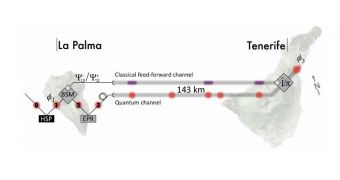Chinese experts were able a few weeks back to set a new world record for the distance over which teleportation is possible. The Asian group announced that it managed to teleport data over a little less than 100 kilometers (60 miles), but now European researchers set a new record.
A group of physicists was able to transfer the information stored on a stream of photons from La Palma to Tenerife, two islands off the Atlantic coasts of northern Africa. The two locations are about 150 kilometers (93 miles) apart. This represents a 33 percent improvement over the previous record.
The study was led by experts at the Institute for Quantum Optics and Quantum Information, in Vienna, who were coordinated by physicist Anton Zeilinger. He says that a large number of problems affected the experiment, delaying it considerably.
Physicists first wanted to conduct the investigation as soon as the setup was ready, but sand storms, sudden temperature changes, winds and strong rain caused them to postpone the tests. Quantum entanglement is a very sensitive state, experts say.
This is the main property that allows teleportation, but it is very prone to breaking down due to influences from the outside environment. “These severe conditions delayed our experimental realizations of quantum teleportation for nearly one year,” Zeilinger explains.
The main goal of conducting teleportation research is establishing quantum communications between ground controllers and satellites in low Earth orbit. However, doing so is very complicated, since the atmosphere interferes with the teleportation beam, breaking quantum entanglement down.
These types of communications are desired because they cannot be intercepted and decoded. Any attempt to observe a quantum beam while it is relaying data would result in the data being scrambled or fully erased, Technology Review reports.
Based on the conclusions of the new study, this ability will soon be achieved in practice. “The technology implemented in our experiment thus certainly reached the required maturity both for satellite and for long-distance ground communication,” Zeilinger concludes.

 14 DAY TRIAL //
14 DAY TRIAL //